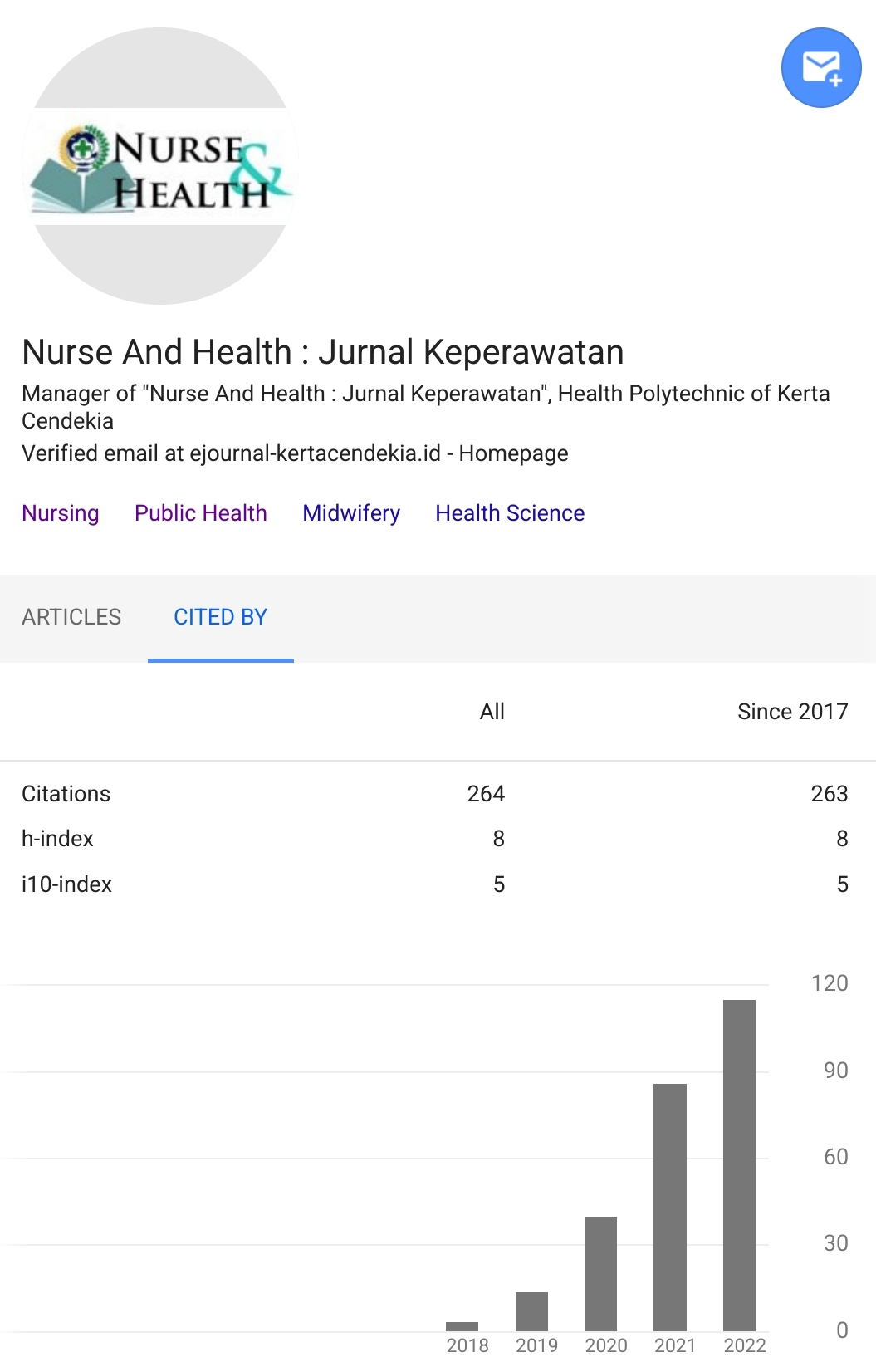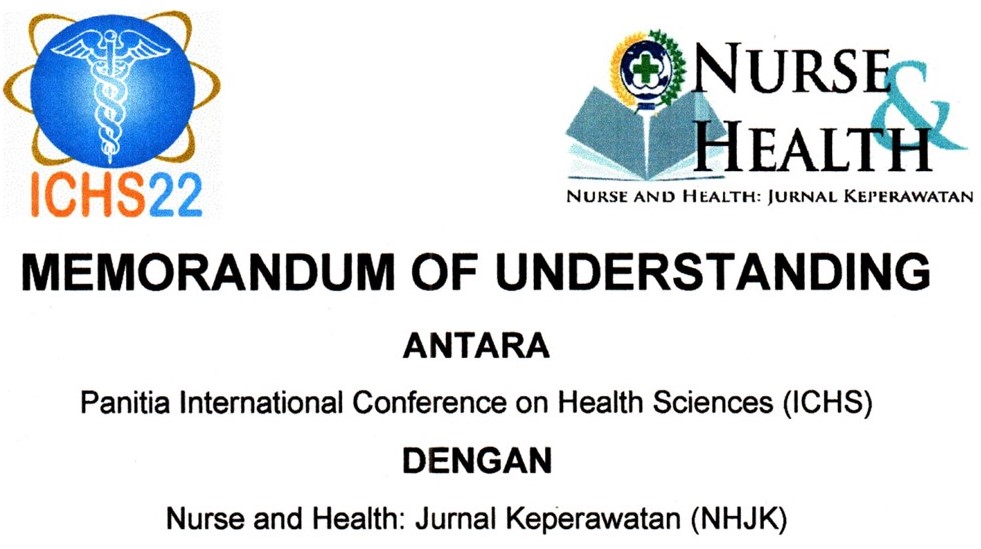NEUROMUSCULAR TAPING IMPROVES MICROVASCULAR CIRCULATION IN TYPE 2 DIABETES MELLITUS PATIENTS
Abstract
Background: The most common complications in Diabetes Mellitus patients are foot problems and high risk for amputation. Factors that trigger problems in diabetic feet in the form of neuropathy factors, namely loss of sensory nerve function and circulatory disorders. One of the non-pharmacological therapies to prevent these problems is safe Neuromuscular Taping (NMT) which is applied to the skin with elastic plaster through a decompression method to prevent a decrease in peripheral blood circulation and improve blood circulation. Objectives: The purpose of this study was to determine the comparison of the effectiveness of Neuromuscular Taping (NMT) intervention on microvascular circulation which was assessed by Ankle Brachial Pressure Index (ABPI) measurement in type 2 Diabetes Mellitus patients. Methods: This study used a quasi-experimental research design with a pretest-posttest control group approach. The number of respondents to this study was 60 type 2 DM patients divided into treatment group respondents and control group respondents. The intervention group was given NMT intervention for 2 weeks with daily plaster changes while the control group was given standard foot care education. The data collected is an ABPI score that describes microvascular circulation using a sphygmomanometer. Analysis was carried out using paired sample t-tests which were used to determine the effectiveness of the intervention. Results: Based on the results of the study, significant changes were obtained in the microvascular circulation of the treatment group (p = 0.000) α 0.05 which is the category of normal microvascular circulation or no disturbance. Increased microvascular circulation is caused by the application of NMT for 2 weeks. Conclusion: There was an increase in microvascular circulation seen through changes in Ankle Brachial Pressure Index (ABPI) values before and after Neuromuscular Taping (NMT) intervention. There were significant differences between the intervention and control groups in changes in ABPI scores.Downloads
References
Alqahtani, K. M., Bhangoo, M., Vaida, F., Denenberg, J. O., Allison, M. A., & Criqui, M. H. (2018). Predictors of Change in the Ankle Brachial Index with Exercise. European Journal of Vascular and Endovascular Surgery, 55(3), 399–404. https://doi.org/10.1016/j.ejvs.2017.12.004 DOI: https://doi.org/10.1016/j.ejvs.2017.12.004
Alves-Cabratosa, L., Comas-Cufí, M., Ponjoan, A., Garcia-Gil, M., Martí-Lluch, R., Blanch, J., Elosua-Bayes, M., Parramon, D., Camós, L., Guzmán, L., & Ramos, R. (2020). Levels of ankle-brachial index and the risk of diabetes mellitus complications. BMJ Open Diabetes Research and Care, 8(1), 977. https://doi.org/10.1136/bmjdrc-2019-000977 DOI: https://doi.org/10.1136/bmjdrc-2019-000977
American Diabetes Association. (2020). Standards of medical care in diabetes-2020. Diabetes Care, 43(SUPPL.). DOI: https://doi.org/10.2337/dc20-S007
Blow, D. (2012). Neuromuscular Taping: From Theory to Practice. Edi-Ermes Medical Publisher, Milan, ITALY. https://www.researchgate.net/publication/332523429_NeuroMuscular_Taping_From_Theory_to_Practice
Cristiningtyas, I. (2018). Pengaruh Penerapan Neuromuscular Taping Terhadap Status Sensori Kaki Diabetik Pada Pasien DM Tipe 2 Di Wilayah Kerja Puskesmas Kota Malang [Universitas Brawijaya]. http://repository.ub.ac.id/id/eprint/167593/1/Ica Cristiningtyas (2).pdf
Cunningham, J. B., & McCrum-Gardner, E. (2007). Power, effect and sample size using GPower: practical issues for researchers and members of research ethics committees. Evidence-Based Midwifery, 5(4), 132–137. https://go.gale.com/ps/i.do?p=AONE&sw=w&issn=14794489&v=2.1&it=r&id=GALE%7CA172050741&sid=googleScholar&linkaccess=fulltext
Dinas Kesehatan Kabupaten Aceh Barat. (2021). Profil Kesehatan Kabupaten Aceh Barat 2020. https://dinkes.acehbaratkab.go.id/
IDF. (2019). International Diabetes Federation: Diabetes Atlas. 9th ed. In International Diabetes Federation. https://doi.org/10.1016/S0140-6736(55)92135-8
International Diabetes Federation. (2021). IDF Diabetes Atlas 10th edition. In IDF. https://doi.org/10.1016/j.diabres.2013.10.013
Kristianto, H., Waluyo, A., Gayatri, D., Yunir, E., & Blow, D. (2021). Neuromuscular taping treatment of diabetic foot: A concept analysis. Clinica Terapeutica, 72(3), 231–235. https://doi.org/10.7417/CT.2021.2320
Kristianto, H., Waluyo, A., Yunir, E., Gayatri, D., & Blow, D. (2020). Neuromuscular taping application opportunities in nursing: a literature review. Http://Cejnm.Osu.Cz/Doi/10.15452/Cejnm.2020.11.0018.Html, 11(3), 143–151. https://doi.org/10.15452/CEJNM.2020.11.0018 DOI: https://doi.org/10.15452/cejnm.2020.11.0018
Monteiro, R. L., Ferreira, J. S. S. P., Silva, É. Q., Donini, A., Cruvinel-Júnior, R. H., Verissímo, J. L., Bus, S. A., & Sacco, I. C. N. (2020). Feasibility and preliminary efficacy of a foot-ankle exercise program aiming to improve foot-ankle functionality and gait biomechanics in people with diabetic neuropathy: A randomized controlled trial. Sensors (Switzerland), 20(18), 1–18. https://doi.org/10.3390/s20185129 DOI: https://doi.org/10.3390/s20185129
Ndraha, S. (2014). Diabetes Melitus Tipe 2 Dan Tatalaksana Terkini. Medicinus, 27(2), 9–16.
Qaribi, M., Suza, D. E., & Tarigan, R. (2021). Effect of education in preventing diabetic foot ulcers to compliance and quality of life the diabetic patients. European Journal of Molecular and Clinical Medicine, 8(3), 3225–3237. https://www.embase.com/search/results?subaction=viewrecord&id=L2013343185&from=export
Shaw KM, C. M. (2012). Diabetes chronic complications. Wiley. https://books.google.co.id/books?hl=en&lr=&id=ASJDrRYwO9cC&oi=fnd&pg=PR7&ots=tXvGVDYaM9&sig=QdroKuknuGEAkJVxOfiV7BVZO3g&redir_esc=y#v=onepage&q&f=false
Susanti, I., & Arofiati, F. (2022). The Effectiveness of Neuromuscular Taping (NMT) And Foot Exercise in Improving Microsirculations in Diabetes Mellitus Patients. Jurnal Aisyah : Jurnal Ilmu Kesehatan, 7(S2), 71–78. https://doi.org/10.30604/jika.v7is2.1408 DOI: https://doi.org/10.30604/jika.v7iS2.1408
Van Laake-Geelen, C. C. M., Smeets, R. J. E. M., Quadflieg, S. P. A. B., Kleijnen, J., & Verbunt, J. A. (2019). The effect of exercise therapy combined with psychological therapy on physical activity and quality of life in patients with painful diabetic neuropathy: A systematic review. In Scandinavian Journal of Pain (Vol. 19, Issue 3, pp. 433–439). Scand J Pain. https://doi.org/10.1515/sjpain-2019-0001 DOI: https://doi.org/10.1515/sjpain-2019-0001
White, R., & McIntosh, C. (2008). Topical therapies for diabetic foot ulcers: standard treatments. In Journal of wound care (Vol. 17, Issue 10). J Wound Care. https://doi.org/10.12968/jowc.2008.17.10.31305 DOI: https://doi.org/10.12968/jowc.2008.17.10.31305
WHO. (2016). Global report on Diabetes. http://www.who.int/diabetes/global-report/en/.
Copyright (c) 2024 Rizki Andriani, Mahanta Qaribi, Roofi Asma Putri, Arif Fadhillah, Sabrina Helmi, Delia Septiani

This work is licensed under a Creative Commons Attribution-NonCommercial 4.0 International License.
Authors who publish with Nurse and Health: Jurnal Keperawatan agree to the following terms:
- Authors retain copyright licensed under a Creative Commons Attribution-NonCommercial 4.0 (CC BY-NC 4.0), which allows others to remix, tweak, and build upon the authors' work non-commercially, and although the others' new works must also acknowledge the authors and be non-commercial, they don't have to license their derivative works on the same terms.
- Authors are permitted and encouraged to post their work online (e.g., in institutional repositories or on their website) prior to and during the submission process, as it can lead to productive exchanges, as well as earlier and greater citation of published work (See The Effect of Open Access). Authors can archive pre-print and post-print or publisher's version/PDF.







_resize1.jpg)















